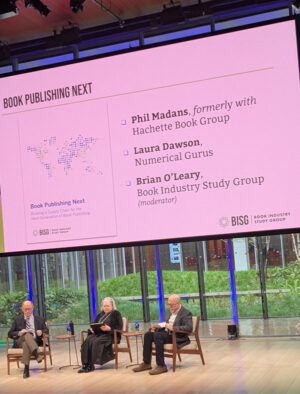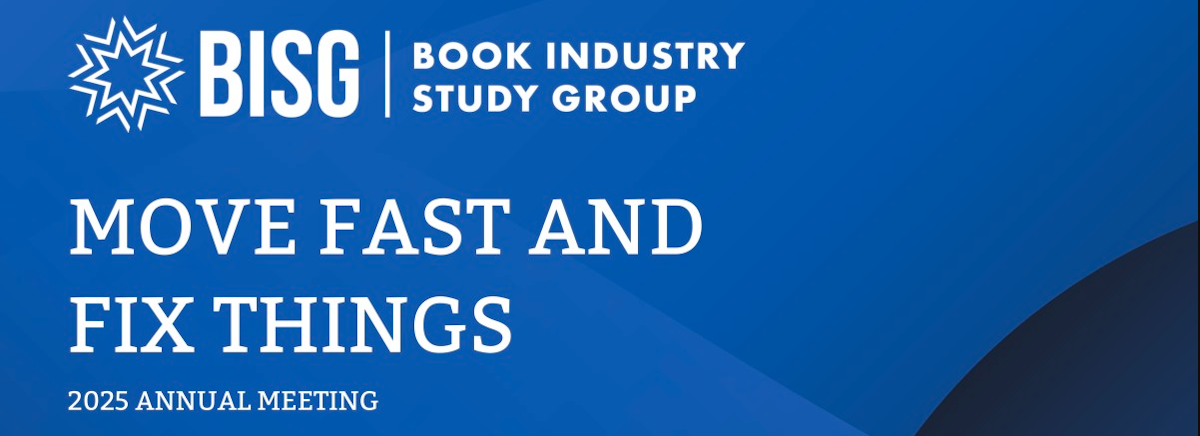The Book Industry Study Group (BISG) is one of the most important organizations serving the book publishing industry, primarily because their mission is explicitly focused on collaboratively solving problems that affect the entire supply chain — including publishers, manufacturers, wholesalers and distributors, libraries, retailers, and industry partners.
They’re not about advocacy or lobbying; they don’t mistreat or sue anybody; and the only attention they want is from the industry they’re trying to help. With a full-time staff of only three people, it’s a mostly volunteer-driven organization working on important behind-the-scenes challenges like metadata, rights, supply chain, subject codes (BISAC), and workflow.
I was thrilled to attend their Annual Meeting for the first time this year (April 25, 2025) and enjoyed the programming almost as much as re-connecting with a bunch of industry friends I hadn’t seen in a while, a few of whom shared some excellent insights onstage, too.
BISG’s 2025 Annual Meeting
Despite the clever tagline, the program for this year’s meeting would not be considered sexy by most people, sadly including many within the industry itself. Most people are wrong, though.
Supply chain challenges, BISAC, updates from working committees, and a few internal awards aren’t likely to generate a ton of media coverage or social activity, but the topics discussed — and individuals honored — offered more practical insights than many multi-day industry programs chasing the latest trends. AI even made its “inevitable” appearance a couple of times, but it was relatively level-headed compared to the usual hype-driven marketing polluting so many other forums these days.
I took a ton of old-fashioned notes, most of which were reasonably legible a few days later, and here’s some of my favorite takeaways.
Barnes & Noble
“Move fast in small increments.” James Miller, B&N
Miller offered insights into some of the changes B&N has made in recent years, particularly the shift to “local control” for book buying and merchandising. This required building new tools to facilitate decentralized ordering, which is at the “community” level, not necessarily individual stores. That suggests a regional system rather than full independence, which makes total sense for the number of stores they have, although it sounds like merchandising is where each store gets to fully express its local identity.
Interestingly, he referenced McNally Jackson as an ideal example of indie title selection and curation (not sure which of their five locations he meant, though), rather than highlighting one of his own stores.
Book Publishing Next
“It still works, but it could be better.” Phil Madans, Hachette Book Group
 Book publishing often gets knocked as a “legacy” industry, and while that’s technically true, it’s also weathered the digital transition better than most other media industries, albeit in less visible ways.
Book publishing often gets knocked as a “legacy” industry, and while that’s technically true, it’s also weathered the digital transition better than most other media industries, albeit in less visible ways.
Madans’ long career began in the pre-computer days, and he took attendees on a trip down memory lane, noting that the existing supply chain was built for print — not digital nor engaging directly with consumers — and industry standards are relatively new, requiring new systems and fresh eyes to take full advantage of. The former can be expensive and daunting, while the latter… publishing isn’t exactly known for being a welcoming place for fresh eyes.
The co-author of the related white paper that was released later in the day (see below), he acknowledged that publishing was “a reactive industry” and the “supply chain isn’t agile enough for the 21st century.”
Laura Dawson, recently returned to the publishing industry, offered some important context, saying ISBNs and ONIX are critical standards that are exemplary compared to other media industries, which are typically siloed into proprietary systems. They’re also foundational elements of a healthy digital ecosystem, which I wholeheartedly agree with.
BISAC
“No critical mass.” Geraldine Zephirin , B&N
Inconsistent use of subject codes is one of my many metadata pet peeves, second only to not using them at all. Years ago, Dawson and I debated the importance of metadata, as she believed it could be a game-changer while I assumed it would simply be table stakes, and everyone would quickly be on a level-playing field. I couldn’t have been more wrong as the only thing standardized about publishers’ metadata is that it’ll be messy. Messy in different ways, but very much a competitive differentiator for the ones using it well and keeping it clean.
Despite my knowing (and frequently soapboxing about) the value of good BISAC usage, I’d never heard of BISAC Merchandising Themes before seeing the meeting’s agenda several weeks ago, and few of those in attendance said they were using them, despite B&N starting to accept them last year. Designed to support discoverability for cultural heritage, holidays and events, noteworthy topics, and even publisher type, they’re a useful signal for retailers and librarians looking for titles they might otherwise miss for curation and merchandising opportunities.
The Cultural Heritage themes are particularly useful for indicating a book’s relevance when appropriate subject codes don’t exist, while also helping avoid the same small group of titles and/or authors dominating “curated” lists year after year.
Zephirin noted that B&N has fewer than 100,000 titles with Theme codes, which limits their usefulness because only a relatively small group of publishers are actually using them. ProQuest’s Michael Olenick offered some simple mapping ideas publishers could use to quickly add the Themes to existing titles, or suggested they prioritize it for new releases. It’s a chicken-and-egg situation where publishers don’t think it’s worth the effort because not enough retailers are using them, while retailers are slow to prioritize it because not enough publishers are using them.
Personally, if B&N is asking for them, that should be a good enough starting point for most publishers, especially knowing that it’s a reactive industry, so other retailers will eventually follow along when B&N starts using them. Waiting for Amazon to support something is basically ceding that opportunity to Amazon and the Big 5.
Let the Book Be the Book: Reconsidering Our Relationships with Text & Technology
“Suspended inscription.” Matthew G. Kirschenbaum
Keynote Conversations are tricky to pull off because they require the right combination of a compelling topic and two people with chemistry and expertise to make it interesting, especially as the final session of the day. I was very familiar with Jeff Jarvis and didn’t know anything about Kirschenbaum, but I now have the latter’s Track Changes: A Literary History of Word Processing on my wish list for future consideration.
Similar to Madans, both speakers brought an interesting historical perspective to the topic, going all the way back to the impact linotype had, effectively opening the door for what became mass media. Having grown up at the dawn of the personal computing era, Kirschenbaum’s insights on word processing were more relatable, particularly for its impact on genre writers who needed to write faster to earn a consistent living from writing. (See also ebooks and, sadly, AI.)
They also noted how computers fundamentally changed the writing and editing process thanks to “suspended inscription,” that expanded space in time between the words being typed and them ending up on a piece of paper. Writers editing themselves became an irresistible expectation for editors and writers, and the quality of writing arguably improved significantly as the editing process became easier for everyone involved. It still required human intervention and expertise, but advances in technology made the process easier for those humans.
Inevitably, the conversation drifted to AI, and while both presumed its inevitability, when asked (by me!) to identify two specific use cases publishers should take seriously and one they should avoid, their answers were underwhelming. Kirschenbaum suggested “reader control AI” that would allow you to tweak a story in different ways, according to your own preferences. Jarvis suggested an alternative to NotebookLLM, allowing you make a database of your own work that you could query. Neither was terribly impressive nor inevitable, but I appreciated Jarvis’ other, more enthusiastic response, pleading with publishers to not use AI to create more content!
Lee Wind & Dominique Raccah
Wind and Raccah were both honored during the meeting, with the Industry Champion Award and Sally Dedecker Award for Lifetime Service, respectively.
I knew Wind from IBPA, but I wasn’t aware of his full background as an author himself and had somehow missed the announcement of their “We Are Stronger Than Censorship” campaign. I’m usually leery of marketing stunts related to banned books, but he gave a great presentation about the program, and I was impressed, particularly by the participating publishers and selected titles, and the partnership with EveryLibrary.
Raccah is one of a handful of modern industry icons I have the utmost respect for and was glad to be present for her recognition. She’s been an innovator throughout her career, willing to experiment and fail in areas most publishers won’t touch, and rather than just accepting her flowers, her speech was an inspiring call to action. When she touched on AI, I reflexively grimaced, but it was the kind of level-headed take the industry needs to hear more often and I hope BISG posts it because I was too engaged to take notes.
If more people in the industry spoke as clearly and pragmatically about AI’s potential place in publishing as Raccah and Mary McAveney (ABRAMS) have, maybe skeptics like me would be open to exploring legitimate use cases rather than being immediately repelled by the empty hype from pundits that gets the most attention?
Credibility matters.
BISG is Important
I was really hoping Brian O’Leary would repeat his great line from last year’s Publishing Innovation Forum, but since he didn’t, I’ll repeat it as my main takeaway: “Make progress among the willing.”
BISG plays a critical role in helping identify industry challenges and develop collaborative solutions, and they’re uniquely positioned to do it because they’re the only organization made up of members from across the supply chain, and they can legally convene without antitrust concerns. Their Committees and Working Groups have some noteworthy initiatives (a handful of which directly involve libraries), and they’re all driven by volunteers.
If your employer is a member organization, you should see if there are ways you can get involved to help. If they’re not a member, you should encourage them to check it out so you can get involved.
NOTE: I’ve read the “Book Publishing Next” white paper they released at the meeting, but I’m still formulating my thoughts on it and will have a separate post about it if I have anything interesting to say. I assume it will be made available soon in their Knowledge Center, so bookmark that link and keep an eye out for it. [UPDATE: It’s now available to read.]
Do you like email?
Sign up here to get my bi-weekly "newsletter" and/or receive every new blog post delivered right to your inbox. (Burner emails are fine. I get it!)


Thank you for such a helpful summary. I was unable to attend this year, after many years in a row. Hope to see you there next year!
I’m glad I finally went. Now I’m trying to find out if non-members can volunteer because I want to get more involved, but it’s expensive!